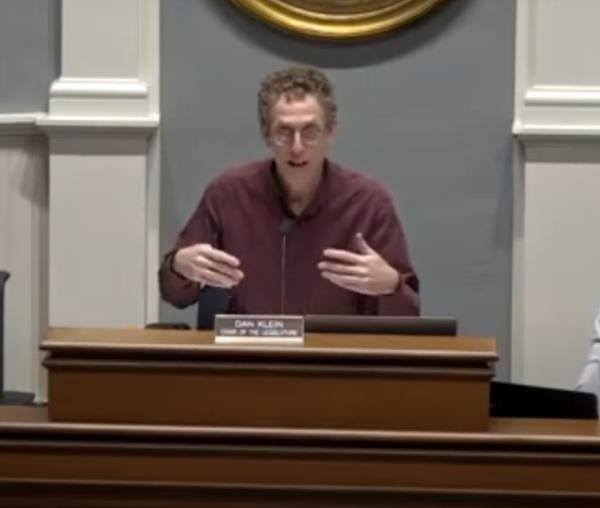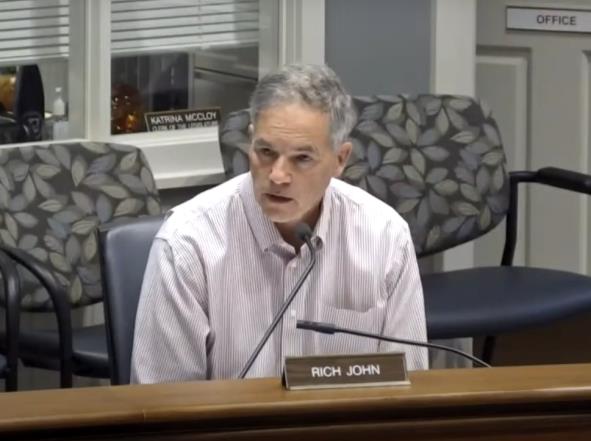Tompkins asks NY to classify EMS an Essential Service
Reporting and Commentary by Robert Lynch; November 26, 2024
The idea is one easy to love and hard to hate… until you consider its implications. Tuesday, November 19th, the Tompkins County Legislature looked only upward, not to the downside.

By a unanimous vote and after a bare six minutes of discussion closing a laborious, four-hour meeting, the Legislature called upon the New York State Assembly—and also, by implication, the State Senate— to “recognize Emergency Medical Services as an essential service” and when it does, “to take all necessary steps to ensure that this recognition is implemented statewide.”
In this Enfield Councilperson’s opinion, and knowing Albany’s predilections as he has for the past seven decades, that last command sounds downright scary. It could prompt Albany overlords to dictate that every municipality, no matter how rich or how poor, have at the ready a fully-staffed ambulance service round the clock, or else pay someone else to provide one, every community paying the bill with its own town taxes.
Worst case: Not only would your January bill carry lines for County Tax, Town Tax, and Fire Tax. It would have an “Ambulance Tax” as well.
Dan Lamb, Town Councilperson in Dryden, has this fall pressed the EMS initiative harder than has anyone else. Lamb hustled it through the Tompkins County Council of Governments (TCCOG) on September 26th. I, Enfield’s representative, couldn’t attend that day. I wish I had. This misguided initiative cries out for a two-sided discussion.
“We would love your support for this call to New York State,” Lamb told the County Legislature in his follow-up advocacy November 19th, “because this is very important that we treat this service just like we treat fire service that government is responsible for maintaining.”
“And we don’t have uniformity throughout Tompkins County or throughout our towns in terms of what type of entity is operating and what standards they’re meeting,” he counseled.
“When you call 9-1-1, the call goes out and you just assume an organization’s going to show up there,” Dryden’s Lamb reminded lawmakers.” The fire truck will show up, he said. So the ambulance should do so as well.
The difference of course, is that there’s no private company that fights fires. Government must do it. But for us locally, there still exists the privately-run Bangs Ambulance Service. Bangs answers most EMS calls within Enfield.
Dan Lamb became the star of the Legislature’s meeting that night. Nursing an injured foot and with another meeting yet to attend, Lamb was permitted to speak first. He made his case and then left. This writer, your Enfield Councilperson, got his turn to speak about 20 minutes later. My remarks were not as prominently placed, perhaps. But I hope I delivered them with comparable passion.
“I see the problem here as, yes, this is a product of good intentions,” I assessed Lamb’s pitch to the Legislature. “But it also carries with it unintended consequences. And that is the question of an unfunded mandate from the state.”

“We in Enfield are in a little different position than Dryden is,” I contrasted our municipal postures. “Dryden has a paid ambulance service… We in Enfield do not have an ambulance service. We cannot afford an ambulance service. And if we were to try to undertake that kind of expense, it would break our budget. And that’s the concern.”
Several hours after I had spoken, during what little debate legislators chose to give the matter before they voted, County Legislature Chair Dan Klein took exception to what I had said.
“I just wanted to say that the Councilperson from Enfield’s comments were not appropriate to this resolution, in my opinion,” Klein countered, “because we’re saying we believe mandatory coordination of EMS services at the county and inter-county level is the best method. So we’re not asking for the towns to step in. We’re asking for the counties to be given the responsibility.”
Criticism received and acknowledged. But Dan Klein reads too much, I would argue, into the second, “resolved” paragraph of the adopted EMS recommendation. A wiser, more realistic reading places the second paragraph as only a hesitant and wandering-away servant to the first.
County coordination is a nice idea, yet it’s never a guarantee. What matters most with this sort of thing is the mandate itself; the “do-it-or-else” clause. And New York State has long proven that it can and will impose a requirement on local government any way it chooses.

Moreover, Tompkins County has shown itself not particularly receptive to the idea of running—and funding—its own fleet of ambulances to ply our county’s highways and back roads. When Tompkins drew the boundaries last year for its Rapid Medical Response (RMR) service, its bare-bones EMT effort to gap-fill and prop up volunteer rescue squads, legislators categorically rejected a more-ambitious option of running ambulances. A municipal ambulance service, it reasoned, would simply cost too much money.
“I think Robert Lynch has a point,” legislator Rich John commented during the resolution’s truncated discussion. “This might end up putting extra burdens on municipalities, but I don’t think we can determine that yet.”
Rich John chairs the Legislature’s Public Safety Committee, the one that oversees emergency services. In his words, he’d like New York State to “step up the way it probably should” and bolster emergency medical funding. His is a well-placed, lofty goal, of course. But results are what matter, and the Empire State’s involvement in propping up home-town ambulance services hasn’t exactly won it any medals.
Follow the money. New York’s poor track record on EMS could spring from high-powered lobbying by private ambulance firms, services that lose money whenever those like Dryden’s shoulder more burden and transport more patients.
“But the alternative to this resolution, Rich John lamented before he voted, “is letting things sort of continue as they are, and that doesn’t seem to be working very well.” John voted aye.

The Resolution that Rich John and everyone else supported that night deserved first a leisurely stroll through the local Legislature’s committee process, something it never got. Instead, Dryden legislator Greg Mezey—no doubt, prodded by Dan Lamb and by other hometown interests—pushed the EMS endorsement onto the November 19th agenda as a “member-filed resolution.” The action provided neither the Enfield Town Board, nor any other body with like-minded concerns the opportunity to weigh in.
And there’s no immediacy here. The New York State Legislature cannot consider or act on the EMS “essential service designation” until January at the earliest.
But Dan Lamb’s words last Tuesday night provided more muscle than did anyone else’s. Lamb’s salesmanship was artfully embedded within a message of compassion and innovative progress. How could anyone not vote for something like this, was his theme. Well, some have already resisted. The New York State Assembly failed to adopt the measure last year, even though the State Senate and Governor Hochul had endorsed it. Critics in the Empire State’s lower house must have had a reason.
“Anna Kelles is fully on board with this,” Lamb assured the County Legislature as to our local Assemblyperson’s support. “It just needs more oomph, like a strong Resolution from Tompkins County,” the Dryden Councilperson exhorted.
Dan Lamb drew forth a bit of that “oomph” from other voices on TCCOG that night. An Ithaca Alderperson endorsed it. Caroline Supervisor Mark Witmer spoke in the resolution’s favor, while acknowledging Enfield’s concerns that some cannot pay as much as can others.
“I think we have to do it in a way that’s sensitive to differences in density, that reflect differences in municipalities’ abilities to support initiatives with taxpayer moneys,” Caroline’s Witmer told the Legislature.
Again, like most, the Caroline Supervisor spoke more to the vision than to operational tangles.

With Albany’s mindset, a one-size-fits-all solution often prevails by default. Were New York to demand that counties—and counties alone—underwrite the expense and operational burden, or should New York couple the EMS mandate with heightened or near-total state funding subsidies to stem the hefty drain on town budgets, we would be talking about a much different beast here. But sadly, we are not.
“And again, we can’t afford it in Enfield,” I reminded those in downtown’s chambers of the mandate’s prospective pain. “We’d either have to buy an ambulance; fund it 24/7 with paid people, no doubt; or contract with a neighboring municipality like the Trumansburg ambulance service, or maybe Bangs; and it would come out of the taxpayers’ budget,” I said.
A wiser course, I offered, would be to encourage state adoption of a funding plan for municipal ambulances much as the “CHIPS” program supports local road maintenance. That, too, has been suggested in prior state lawmaking terms, only to die a neglected, forgotten death.
Of course, like so many recommendations Tompkins legislators have endorsed from time to time, what passed its review during that third Tuesday in November may proceed absolutely nowhere. An EMS “essential service” mandate will rise and fall based on what state lawmakers and the Governor choose to do, not what Tompkins County recommends. Sometimes we in local chambers puff up our own chests a bit too much.
And maybe there’s something more than cost to consider. What about intermunicipal harmony?
“I think this could lead to a rivalry between municipalities,” I warned the County Legislature, my thinking the consequences of some messy, mandated, cross-border compensation scheme arising from state government’s intervention.
“You’ve got the poor areas who say we can’t afford it; the rich ones say, please pay us… And that could lead to a kind of a municipal civil war that I wouldn’t like to see.”
The Tompkins County Legislature has spoken. Let’s see where things go from here. There’s still Bangs.
###

